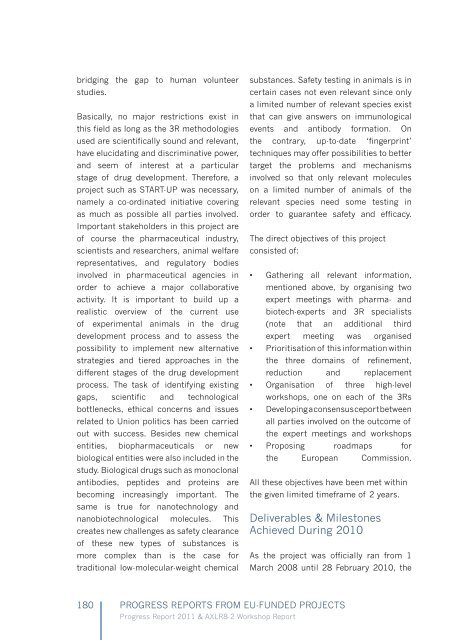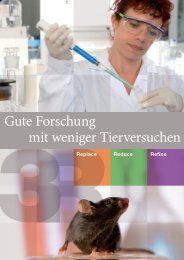Create successful ePaper yourself
Turn your PDF publications into a flip-book with our unique Google optimized e-Paper software.
idging the gap to human volunteer<br />
studies.<br />
Basically, no major restrictions exist in<br />
this field as long as the <strong>3R</strong> methodologies<br />
used are scientifically sound and relevant,<br />
have elucidating and discriminative power,<br />
and seem of interest at a particular<br />
stage of drug development. Therefore, a<br />
project such as START-UP was necessary,<br />
namely a co-ordinated initiative covering<br />
as much as possible all parties involved.<br />
Important stakeholders in this project are<br />
of course the pharmaceutical industry,<br />
scientists and researchers, animal welfare<br />
representatives, and regulatory bodies<br />
involved in pharmaceutical agencies in<br />
order to achieve a major collaborative<br />
activity. It is important to build up a<br />
realistic overview of the current use<br />
of experimental animals in the drug<br />
development process and to assess the<br />
possibility to implement new alternative<br />
strategies and tiered approaches in the<br />
different stages of the drug development<br />
process. The task of identifying existing<br />
gaps, scientific and technological<br />
bottlenecks, ethical concerns and issues<br />
related to Union politics has been carried<br />
out with success. Besides new chemical<br />
entities, biopharmaceuticals or new<br />
biological entities were also included in the<br />
study. Biological drugs such as monoclonal<br />
antibodies, peptides and proteins are<br />
becoming increasingly important. The<br />
same is true for nanotechnology and<br />
nanobiotechnological molecules. This<br />
creates new challenges as safety clearance<br />
of these new types of substances is<br />
more complex than is the case for<br />
traditional low-molecular-weight chemical<br />
substances. Safety testing in animals is in<br />
certain cases not even relevant since only<br />
a limited number of relevant species exist<br />
that can give answers on immunological<br />
events and antibody formation. On<br />
the contrary, up-to-date ‘fingerprint’<br />
techniques may offer possibilities to better<br />
target the problems and mechanisms<br />
involved so that only relevant molecules<br />
on a limited number of animals of the<br />
relevant species need some testing in<br />
order to guarantee safety and efficacy.<br />
The direct objectives of this project<br />
consisted of:<br />
• Gathering all relevant information,<br />
mentioned above, by organising two<br />
expert meetings with pharma- and<br />
biotech-experts and <strong>3R</strong> specialists<br />
(note that an additional third<br />
expert meeting was organised<br />
• Prioritisation of this information within<br />
the three domains of refinement,<br />
reduction and replacement<br />
• Organisation of three high-level<br />
workshops, one on each of the <strong>3R</strong>s<br />
• Developing a consensus ceport between<br />
all parties involved on the outcome of<br />
the expert meetings and workshops<br />
• Proposing roadmaps for<br />
the European Commission.<br />
All these objectives have been met within<br />
the given limited timeframe of 2 years.<br />
Deliverables & Milestones<br />
Achieved During 2010<br />
As the project was officially ran from 1<br />
March 2008 until 28 February 2010, the<br />
180 PROGRESS REPORTS FROM EU-FUNDED PROJECTS<br />
Progress Report 2011 & AXLR8-2 Workshop Report




